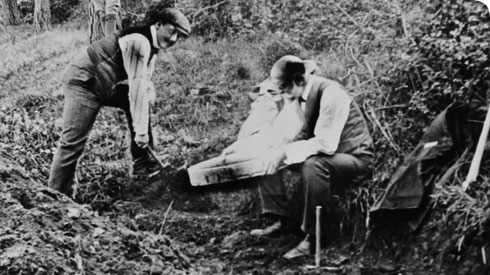Piltdown suspects
It is almost 60 years since Piltdown Man was revealed as a forgery. But who did it? And why?
Many people have been suspected but still no one really knows the answer. Discover some of the key suspects.

Charles Dawson (1864–1916), the solicitor and amateur fossil hunter who found Piltdown Man and took the first fossil fragments to Smith Woodward at the Natural History Museum. Dawson found many other fossils over the years and several of these have also been revealed as fakes. No more evidence of Piltdown Man was ever found after Dawson's death in 1916. Dawson is the prime suspect, working either alone or with accomplices.

Arthur Smith Woodward (1864–1944), Keeper of Geology at the Natural History Museum, who announced Piltdown Man to the world. Smith Woodward was a meticulous scientist and is best known for his authoritative work on fish fossils. He gave a stamp of respectability to the finds, although he had limited expertise relating to fossil humans. Following retirement in 1924, he moved to Sussex and continued to dig for evidence of Piltdown Man. Smith Woodward had the opportunity to carry out the fraud, but few believe he did it.

Pierre Teilhard de Chardin (1881–1955), a young Jesuit priest who completed his training in Hastings around the time of the Piltdown discoveries. Teilhard first met Dawson in 1909 and then started helping Dawson and Woodward with the dig at Piltdown in May 1912. He found the canine tooth, a crucial piece of evidence. Teilhard was considered the most likely culprit by Stephen J Gould, writing in 1980. He went on to become a famous philosopher.

Martin Hinton (1883–1961), who worked with Smith Woodward at the Museum. In 1978 an old trunk of Hinton's was found in a loft above an office he occupied from 1936 to 1945 while Keeper of Zoology. It contained bones and teeth stained in a similar way to the Piltdown remains and some carved in the same manner as the elephant-bone cricket bat. Other stained teeth were also found in an old tobacco tin of his. Was Hinton investigating Piltdown or did he create the fakes?

Arthur Conan Doyle (1859–1930), author of The Lost World and creator of Sherlock Holmes. Conan Doyle lived near Piltdown and knew Dawson. Originally qualified as a doctor, Conan Doyle found success as a writer. He became a spiritualist following a series of deaths in his family and has been accused of carrying out the Piltdown fraud as revenge against the opposing views of science.
